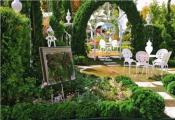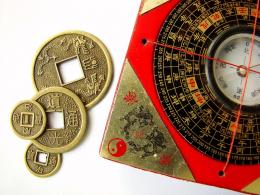Search
Login
Recommended
Planning a Feng Shui Garden at a Personal Plot
Everyone who is interested in the wisdom of the East knows that the Chinese folk art of Feng Shui, recognized as an inexhaustible source of wisdom of the peoples of the East, which has remained relevant for centuries, is still at the peak of popularity. According to the main conceptual direction of the doctrine, nature, space and man are components of a single world in which everything is built on clear relationships, and a break in these relationships can lead to truly devastating consequences. The circulation of qi energy or, as the Chinese call it, the energy force of life, is the basis of these directing connections, recognized as the fundamental link in the doctrine.
Content
- The basic concepts of the teachings of Feng Shui. Qi energy
- The basics of garden planning in feng shui. Home location video
- We comply with the basic principles of zoning. Bagua Octagon
- Water as the main conductor of qi energy. Principles of creating a reservoir
- Plants are the final link in the garden. We form a garden space
The basic concepts of the teachings of Feng Shui. Qi energy
Speaking about the basics of the teachings of Feng Shui, it is important to remember the dominant parts or substances. There are five of them: water - the collector and reflector of qi energy, wood - the dominant of all teachings, earth, as well as fire and metal. From the point of view of the founders of Feng Shui, they do not have a material nature, and personify the energy of the cosmos, which is associated with the substance of qi, circulating in a circle between the five main components.

According to another dominant concept of Chinese teaching, called the Bagua polygon, any area, also a garden plot, has the following zones:

- North quarry;
- northeast intelligence, spiritual growth;
- northwest travel area;
- south zone of fame;
- southeast wealth;
- southwest family relationships, marriage;
- West zone of the future, children and creativity;
- east zone of the past, family.

The basic concept of Feng Shui for the garden is that the site should be correctly located in the territory that meets the rule of a comfortable chair, that is, the front of the site should have a peaceful view of the calm water source, and on the remaining three sides should be reliably protected by tall hills or trees.

According to the principles of Feng Shui, the geometry of the garden plot is no less important than its location, on which qi energy circulation also depends.

That is why it is preferable to choose areas of the correct geometric shape, rectangular or round, which does not create any obstacles to the proper circulation of fundamental energy.


The basics of garden planning in feng shui. Home location
Since water is considered the main source of qi energy, which determines its direction, the optimal placement of the house relative to the main water sources is very important. The best location option is when a winding river or a large stream flows past your house, going around it with a smooth route.

The location of the house between a smooth curving path or a river characterized by a moderate course is welcomed, while the central path should also be curved, its smooth bends make the flow of qi energy more moderate.

Feng Shui of the summer cottage also states that it is urgent to get rid of sharp corners aimed at the house (this can be a road intersection, sharp corners of adjacent buildings or narrow openings between them), since they are a kind of negative energy of sha, which destroys energy harmony .

It is possible to secure its destructive effect by creating a hedge in front of the house, a small decorative fountain at the entrance to the house, or a high threshold that neutralizes the effects of bad energy. Crossed swords located at the front door of the house also have a neutralizing effect.

We comply with the basic principles of zoning. Bagua Octagon
The layout of the garden, according to the principles of Feng Shui, and zoning of the territory have much in common. This indicates that the first stage of planning is to determine the purpose of the garden territory (rest, planting cultivated plants), the choice of the stylistic direction, the determination of the necessary elements of the personal plot and the final zoning of the garden according to the Bagua octagon.

Before zoning, you need to identify the relationship of the garden with one of the five fundamental elements of Feng Shui teachings. For these purposes, stand with your back to the garden house and pay attention to the side of the world that you are facing. It determines the subordination of the garden to one of the five elements. Consider the described relationship, from the point of view of the principle of orientation, submission:

- east, southeast tree;
- south fire;
- southwest land;
- west northwest direction metal;
- northeast water.

Having determined this correspondence, you need to add an element to the garden that is able to balance energy, for example, if the garden is subordinate to fire, you need to add water.

According to the octagon principle, the correct zoning and arrangement of the garden can multiply the impact on separately located zones. Thus, when applying the bagua scheme to the garden plan, the career zone should be at the entrance to the garden, in this zone it is recommended to have a fountain or other water source, symbolizing the course of life.

The children's area is perfectly complemented by a playground and fruit bushes; the family zone will flourish if you place a gazebo in it,

alpine hill or greenhouse;

the zone of glory corresponds to garden sculpture, and the zone of intelligence and spiritual growth is a clean, self-renewing source and rose garden, the location of which can be an excellent territory for meditation. In the family zone, you can place a patio or swimming pool, and the center, or the so-called tai chi zone, is an ideal place for locating a lawn or gravel site.

A house on a garden plot should be an ideal complement to it, the lines should be soft, without abrupt transitions, and paving should be carried out using natural materials. At the same time, paths paved with stone, gravel and bark should not intersect in the central part of the site, and flower beds and artificial ponds should be characterized by an asymmetric shape and irregular edges.

According to the Chinese, the side of the site where the front door is located is the face of the owners, and that is why the design of the entrance area should be treated with due care. It can be issued using a plate located on the door, a refined shape lantern, or plants in containers that should not be arranged symmetrically.

Water as the main conductor of qi energy. Principles of creating a reservoir
According to the fundamental principles of Feng Shui, a site where there is no body of water is not designed according to all the rules. Since water attracts qi energy and significantly increases it, it is not recommended to refuse to create a reservoir in the area. Moreover, flowing water is a symbol of material well-being, and from a practical point of view, an ideal way to attract butterflies, dragonflies and small animals to the site.

The correct location of the reservoir is the southern or eastern sector of the garden, while the total solar illumination of the reservoir should not exceed 5 astronomical hours per day. The size of the reservoir should not exceed the parameters of the house located on the site, as it is not the dominant link, and should not be located under the trees.

Plants are the final link in the garden. We form a garden space
The decisive link that affects the formation of the garden space are plants. The role of plants on the site is extremely high: they change their appearance throughout the year, symbolizing the changes taking place in nature, clear the site of negative energy and have a huge aesthetic impact.

All this directs the energy flow of qi in the optimal direction, creating the ideal energy field according to the concepts of Feng Shui.

The tree is the dominant element of the garden and a powerful source of natural transformation. Therefore, next to the house you need to plant family-type trees: in China, such trees are representatives of conifers, on the territory of the European part there are apple, rowan and maple. According to the fundamental concepts of Feng Shui, a tree cannot be cut and its crown shaped with an artificial haircut. In the art of Feng Shui, flowers are also of no small importance.

They are sometimes able to please a person more than trees or shrubs. The basic laws of Feng Shui say that in different parts of the world you need to plant flowers of various color shades.






